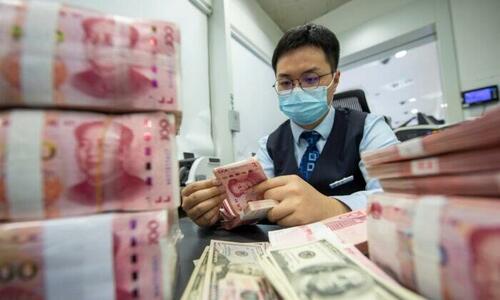Why China Does Not Dare To Solve Its Problems By Printing Large Amounts Of Money
Authored by Law Ka-Chung via The Epoch Times,
China’s proposal of a 300 billion Yuan bank loan to rescue the housing sector is obviously a tiny amount compared to the amount outstanding; I discussed this in last week’s piece here.
At first glance, it looks odd that the proposal orders banks to play the role of lender of last resort instead of the central bank. For most countries facing such a huge crisis, the central bank printing money and injecting liquidity is almost the designated act.
Interestingly, however, the People’s Bank of China did not do anything like this, and there was not even a rate cut cycle.
The reason for such inaction might be severalfold.
First, as discussed here previously, is due to infighting. The billionaires are potential threats to the existing dictatorship regime. The wealthier they are, the bigger the threat. By creating a housing crisis, most billionaires would fall back to being millionaires.
Second, policy inaction could result in a sharper cliff fall, which might end the crisis sooner rather than later. However, this runs a high risk of being overdone because most crises tend to be uncontrollable once started. This is obviously realized in China.
A third but intuitive reason is the standard bad consequences of excess money creation. China did this experiment in the 1940s. The massive money printing led to hyperinflation, which collapsed the currency and, finally, the political regime. The existing ruling regime knows such history well. To maximize their political interests, they would prefer the collapse of the economy via prolonged depression than the collapse of the currency by the latter (but not necessarily for the former) could collapse the political regime.
How likely is this to be true? Money creation has been conducted in many countries like the U.S. and Japan many times without resulting in the collapse of anything.
China is as big as these two countries; one might wonder if there would be the same kind of immunization from hyperinflation or currency collapse after the massive scale of money creation. In fact, they experimented with this in 2009, when M2 expanded at a nearly 30 percent year-over-year (YoY) rate. It turns out there was no pressure for depreciation, but inflation pushed to over 6 percent after two years.
In recent years, the opposite happened. Since 2018, there have been two rounds of monetary expansion where M2 YoY growth reached double digits. The resulting impact was not inflation but deflation due to the debt crisis, yet accompanied by currency depreciation. To see this, the accompanying chart compares the China-U.S. M2 YoY growth gap with the USD and CNY. As China’s M2 growth had exceeded that of the U.S., depreciation would happen after about a year. This shows that excess money creation is really a threat to currency value, as recently experimented.
China-US M2 YoY Gap and USD/CNY(Courtesy of Law Ka-chung)
The only tactic remaining was to print excess money in a relatively ordered manner, letting the currency depreciate gradually, even in the face of a series of defaults resulting in a severe recession. One day, they might devalue the currency sharply, but the uncertainty of doing so is very high.
Tyler Durden
Fri, 05/31/2024 – 11:00

